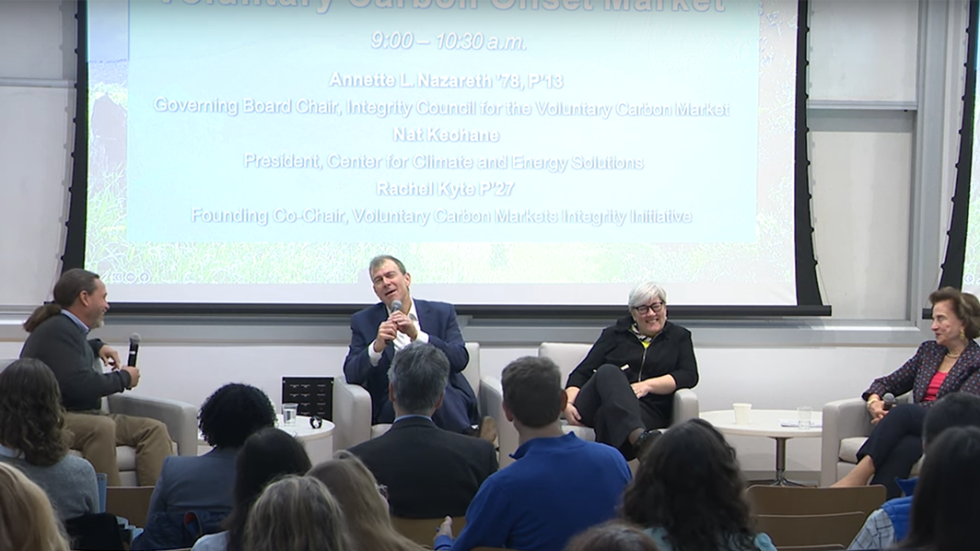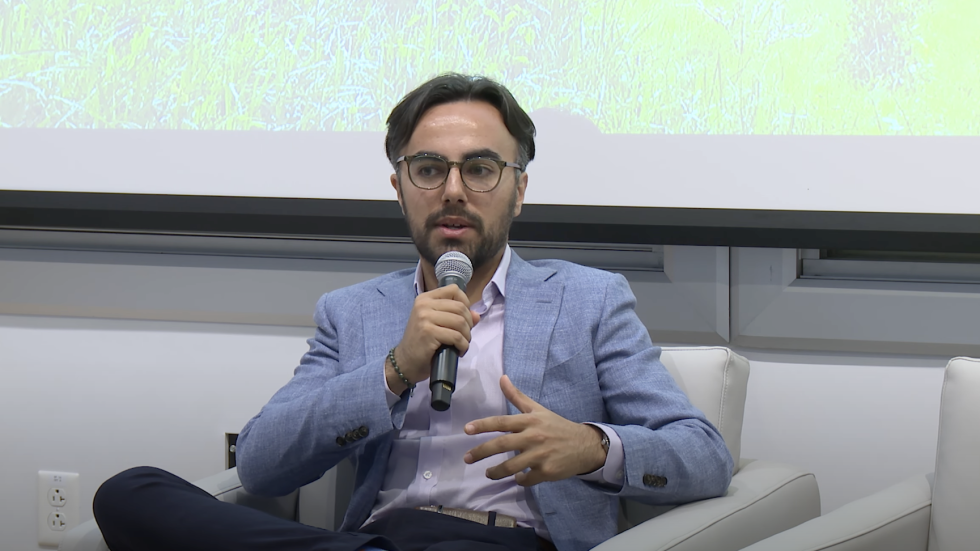Watch | Navigating the carbon offsets conundrum
At a full-day conference in April, attendees from across industries and geographies gained insights into the complexities of carbon offsets and their impact on global efforts to combat climate change.
Challenging assumptions can lead to groundbreaking shifts in perspective. Just ask Stephen Porder, the University’s Associate Provost for Sustainability, whose skepticism about carbon offsetting, combined with a charge to reduce Brown’s emissions, led him to dig deeper into a subject he originally dismissed.
Do companies that buy voluntary carbon offsets actually reduce their efforts to wean themselves off of fossil fuels? What rules exist to avoid greenwashing? What are the best practices for institutions engaging in the voluntary carbon offset market? What are the consequences of these markets for Indigenous peoples whose lands store vast amounts of carbon?
These and other complex issues informed the discussions at Carbon Offsets: Promise, Perils and the Path Forward, held at the Institute at Brown for Environment & Society on Saturday, April 13.
The day-long event included discussions with nine panelists, including several Brown alumni, representing the private sector, organizations developing standards for the voluntary carbon market (VCM), and academia. The speakers discussed the existing tensions in the carbon market, the complex issues faced by innovators striving to address the climate crisis, and whether there is a path to leverage private capital towards carbon offsets as part of a climate solution.
“ It was like a masterclass in modern-day carbon offsets. ”
The conference was a collaboration between the Institute at Brown for Environment and Society, the Office of the Provost, and the Climate Solutions Lab at the Watson Institute for International and Public Affairs, and it was organized and moderated by Brown professors Stephen Porder, James Kellner, and Ricardo Bayon. The program attracted around 200 attendees both online and in person. Attendees included members of the Brown community as well as representatives from various nonprofit and for-profit companies in the climate action sector, along with participants from several Ivy League institutions, such as Columbia, Harvard, and Yale.
Before the event began, Porder said, “I hope everyone will emerge from the conversations thinking differently than they did when they walked in.”
Exploring the implications of carbon offsets
In essence, carbon offsets enable an organization — like a car manufacturer, airline, or university — that emits greenhouse gasses to pay to remove carbon from the atmosphere somewhere else (for example by paying for reforestation, changes in agricultural practices, or to directly pull carbon dioxide from the air and store it underground).
Everyone agrees that a functioning market would be beneficial, but whether such a market can be created in a way that does more good than harm is a matter of much debate. Still, with rising temperatures affecting every corner of the world, the need to achieve the goals of the Paris Agreement is more urgent than ever. The Agreement calls on its 195 signatory countries to limit global warming to 1.5 degrees Celsius in order to achieve carbon neutrality by 2050. Article 6 of the Agreement, which addresses the issues of carbon offsets, is considered contentious.
Porder explained that the April 13 event resulted from the University’s commitment to reduce its net emissions by 75% by 2025. Achieving 50% was possible by switching to renewables, but reaching the university’s goal required using offsets in the short term. The challenge of fully understanding the implications of this strategy, said Porder, drove the decision to host the panels and group discussions.
Even after the conference ended, some 25 individuals stuck around to continue discussing these issues and to lay out ways to continue to work together.
Students’ perspectives reveal insights
Nine Brown students helped promote this event and provided support to the speakers throughout the day-long program. In addition to meaningfully engaging with these experts one-on-one, the students summarized key findings from each panel and reflected on their own perspectives about the panelists’ presentations and the ensuing discussions.
 Play
Play
Carbon Offset Panel #1: The State of the Voluntary Carbon Offset Market. Speakers: Annette L Nazareth '78, P'13 (Integrity Council for the Voluntary Carbon Market), Rachel Kyte P'27 (Voluntary Carbon Markets Integrity Initiative), and Nathaniel Keohane (Center for Climate and Energy Solutions).
During the first panel, “The State of the Voluntary Carbon Offset Market,” described by IBES Director Kim Cobb as a “masterclass in modern-day carbon offsets,” Margaux Terrasson ’24 learned that VCMs could bring desperately needed capital to communities, yet concerns over this market’s shortcomings have stalled demand.
Companies are pursuing VCMs to satisfy shareholders and consumers, although attracting talent appears to remain the largest motivator, learned Lauren Griffiths ’24, who is pursuing a double concentration in International Affairs and Environmental Science. She was also surprised to learn that VCMs comprise some $2 billion of the $900 billion carbon market.
 Play
Play
Panel #2: "Nature-Based" Carbon Offsets. Speakers: Spencer Meyer (BeZero Carbon), David Schurman '20 (Perennial), and Carolina Cardoso Lisboa (Verra).
Tabatha Hirsch ’25 described the second panel, “Nature-Based Offsets,” moderated by James Kellner, IBES’ director of early career development and training, as “contentious,” given the panelists’ divergent perspectives. Kellner encouraged attendees to “consider the tension” between the existing excitement for nature-based carbon credits and the criticism that such offsets receive.
“The carbon market is starting to include ‘insurance’ policies, reflecting maturity,” Hirsch wrote.
 Play
Play
Panel #3: Institutional Engagement in Voluntary Carbon Offsetting. Speakers: David Antonioli (Former CEO, Verra), Tracey Osborne (UC Merced, UC Center for Climate Justice), and Jennifer Jenkins (Rubicon Carbon)
Based on comments and questions from those attending the third panel, “Institutional Engagement in Voluntary Carbon Offsetting,” Tiffany Kuo ’26 discovered that “a lot of change is desired in the VCM space, and I look forward to what’s ahead.”
“The panelists agreed with Professor Porder that carbon offsets are a much speedier way to bring in environmental benefits and ensure a smooth transition to net zero,” recounted Kuo.
Debates among the third panel’s participants about what makes a carbon project “perfect” led Aisha Tipnis ’24 to wonder whether it's better to buy offsets for a carbon project with the purest standards or to buy offsets for bigger projects. Tipnis said, “The future of our planet does depend on the next decade of emissions.”
“ A lot of change is desired in the VCM space, and I look forward to what’s ahead. ”